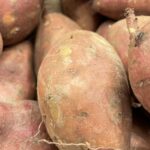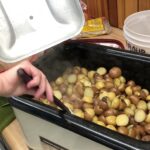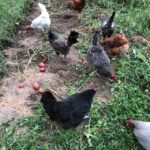Good Friday Tradition
On a cold April morning, we planted a row of potatoes at Winding Pathways. This plant has made an amazing long journey to reach our yard.
Potatoes are native to South and Central America and were cultivated by native people long before Columbus. Early Spanish explorers realized this humble American plant produces an enormous amount of food that’s easy to store. They brought potato sets back to Spain, and eventually, the plant was cultivated throughout Europe.
- Sweet potatoes are a healthy vegetable.
- Potatoes are hardy and plentiful.
Productive Crop
Potatoes produce more human food per square foot than wheat, rice, corn, or nearly any other crop, so crowded Ireland embraced the plant. Potatoes thrived in Irish soil and were so productive they enabled the human population to flourish. Unfortunately, the entire crop was of just one or two varieties. Disaster hit. Between 1855 and 1859 blight killed most of the crop, which lacked resistance to the disease. It caused massive starvation and spurred huge immigration to the United States.
Early Europeans who colonized North America brought potatoes to plant in the New World. So, an American plant crossed the Atlantic Ocean twice in its long journey.
Vandals and Hawkeyes
We both hold degrees from the University of Idaho. It’s the potato state, and the plant loves the light volcanic soil along the Snake River in the southern part of the state. Iowa, where we live, is the corn state, but humble potatoes do well in our garden.
We buy seed potatoes in early spring, cut and cure them, and plant them in early April. They don’t expect much from us, and by mid-summer we carefully hand dig delicious new potatoes. Later, when the tops die back, we dig and cure a bushel, or so, for winter storage.
Expert Resource at Hand
We hedge our bets by planting a few potato varieties, and this year we’re fortunate to have a potato expert move to Cedar Rapids. Jean Contina earned his doctorate degree from the University of Idaho studying potato diseases. He’s a fellow Vandal! We’ll seek his advice on how to maximize our crop.
- Chickens don’t seem to bother the potatoes.
- Beautifully presented dinner.
Inexpensive. Why Grow Them?
Store-bought potatoes are one of the least expensive foods. So why grow them?
We have two reasons. First, anything we grow seems more delicious than its store-bought counterpart. It may be our imagination but it is true. Second, they are an easy crop to grow and store well all winter without the need to can or freeze them. Having potatoes stored in a cool dark room in our house gives us a bit of food security in a crazy world.






We have found that our home-grown potatoes lack the starchy taste of store-bought, and the peels are paper thin and tasty, with no bitterness. Growing them requires little effort. We plant half of our small raised bed with potatoes!
This sounds like a great way to do this!
I planted some spouted spuds in my big deck pots last year for the foliage and had a nice batch of potatoes at end of season. I discovered I didn’t quite get all of them out of the pots and had two potato starts overwinter and now have even larger foliage this year in planters so will be interesting to see what is down below when I dig down this summer.
This is really fun!
Each year I plant at least 5+ hills of Yukon Gold potatoes, my favorite. I like the creamy gold color as well as the taste. This year they are growing beautifully. Some years I also grow my own sweet potatoes. I was a tad late getting to Walter’s Greenhouse this year to acquire my sweet potato seedlings. We might go anyway just to see all the gorgeous flowers in the green house. Being a diabetic I’m careful not to eat too many of the white potatoes. My understanding is that the sweet potatoes have less carbs.
Rich just planted sweet potatoes.